These sugar-loving black-and-yellow wasps nest in the ground. They do swarm, so close encounters may leave a memorable sting…or twenty.
Scientific classification
- Order: Hymenoptera
- Family: Vespidae
- Genera: Vespula
The common name of these insectivorous wasps can be confusing since just about any wasp with black and yellow markings gets called a 'yellowjacket'. True yellowjackets belong to the scientific classification of the genus Vespula. Workers frequent picnics, hummingbird feeders and any other source of sugar that are available. Despite a fierce reputation, they benefit gardens by preying upon nuisance caterpillars, spiders and beetle larvae to feed their young.
DIY Wasp removal recommendations
For non aggressive wasps I've had great luck spraying the nests with this Spectracide wasp remover in the evening. For more aggressive wasps I also use this rediculous looking upper torso Beekeeping suit. It seems silly, but trust me, it's amazing.
Yellow Jacket Wasp Identification
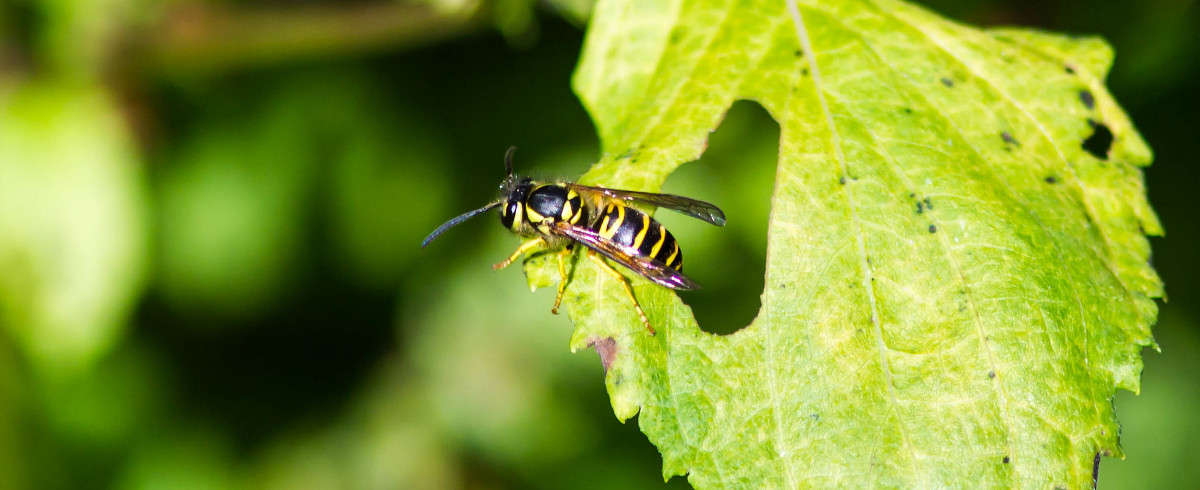 Photo by Melissa McMasters
Photo by Melissa McMasters
The 'yellow jacket' refers to the striking black and yellow markings all over the body of Vespula wasps. Their small size relative to other common wasps is also a quick identifier of yellowjackets. Worker females and males are a half inch in length with a black body and bright yellow markings on the head, thorax, abdomen and legs. The wings are clear and the body is not hairy. If you see an insect that matches most of this description but has a hairy body, you've encountered one of the dozens of species of bees in North Texas.
There are two common species of yellowjackets in the southwestern United States.
Southern Yellowjacket Wasps
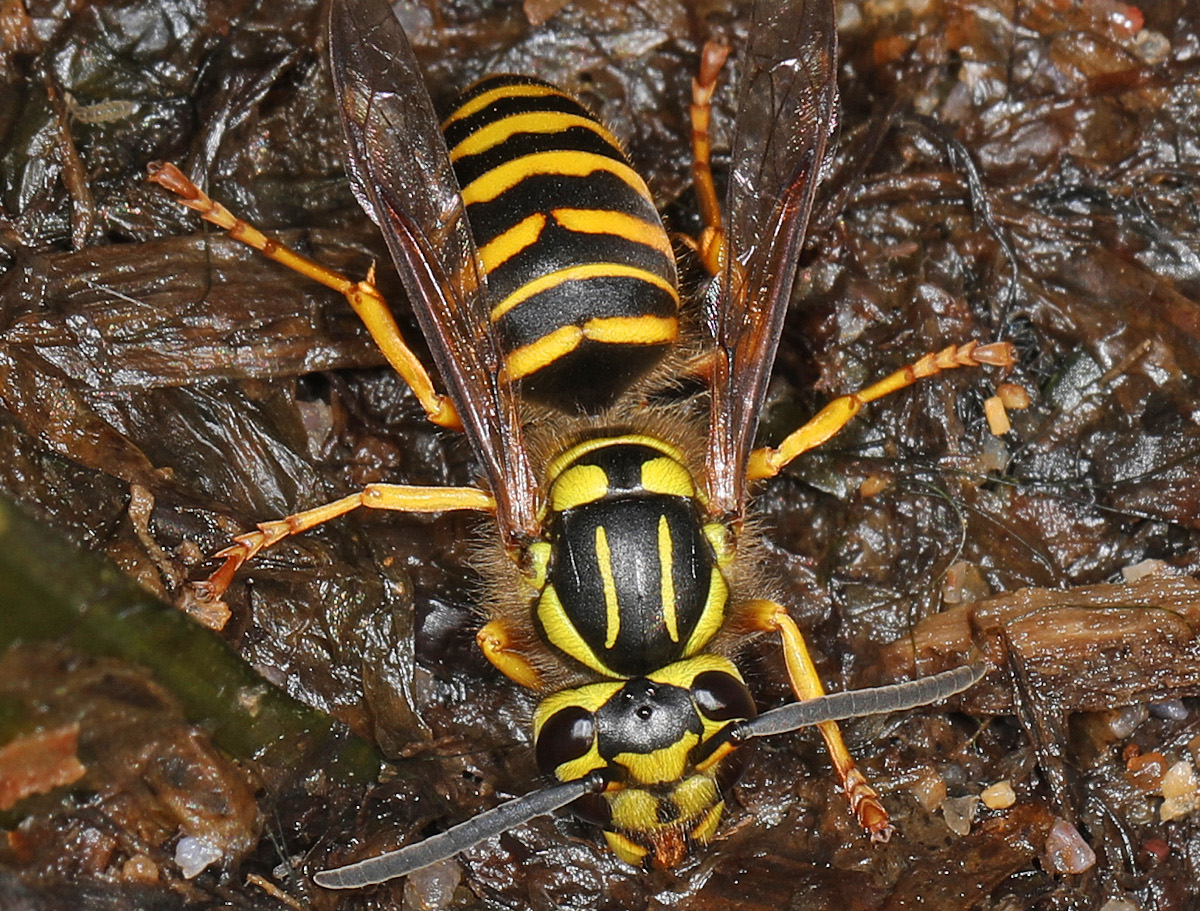 Photo by Judy Gallagher
Photo by Judy Gallagher
The southern yellowjacket (Vespula squamosa) ranges from eastern North America all the way to Guatemala. Queens are noticeably larger (about ¾ inch in length) and orange in color. Southern yellowjacket colonies contain anywhere from 500-5,000 insects at their peak, with activity from early spring through November.
Eastern Yellowjacket Wasps
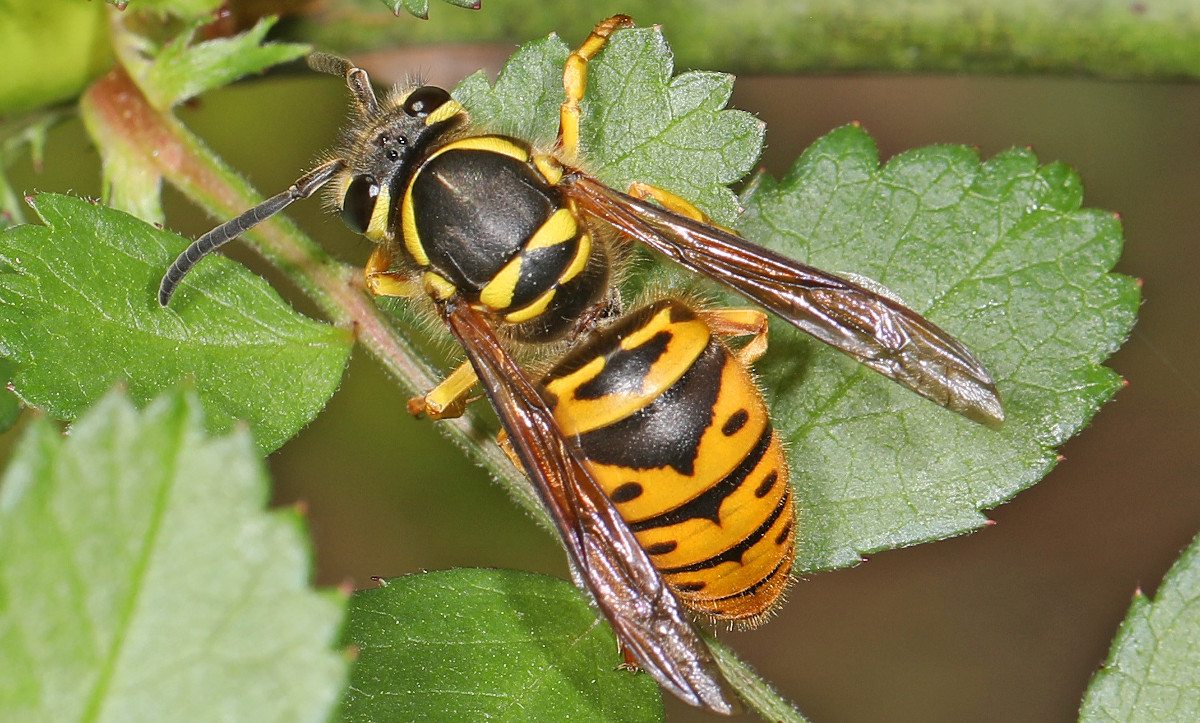 Photo by Judy Gallagher
Photo by Judy Gallagher
The eastern yellowjacket (Vespula maculifrons) is native to the great plains and eastern North America. It is similar in size to the southern yellowjacket, but there are distinctive markings on the abdomen. The lines on the abdomen differ based on a caste system of workers, males and the queen. The abdomens of workers and males have thick black bands with three points on each one. Queens have one flared black line near the thorax followed by thin black lines. They also have two black dots between each black line on the abdomen.
Yellowjacket Nests
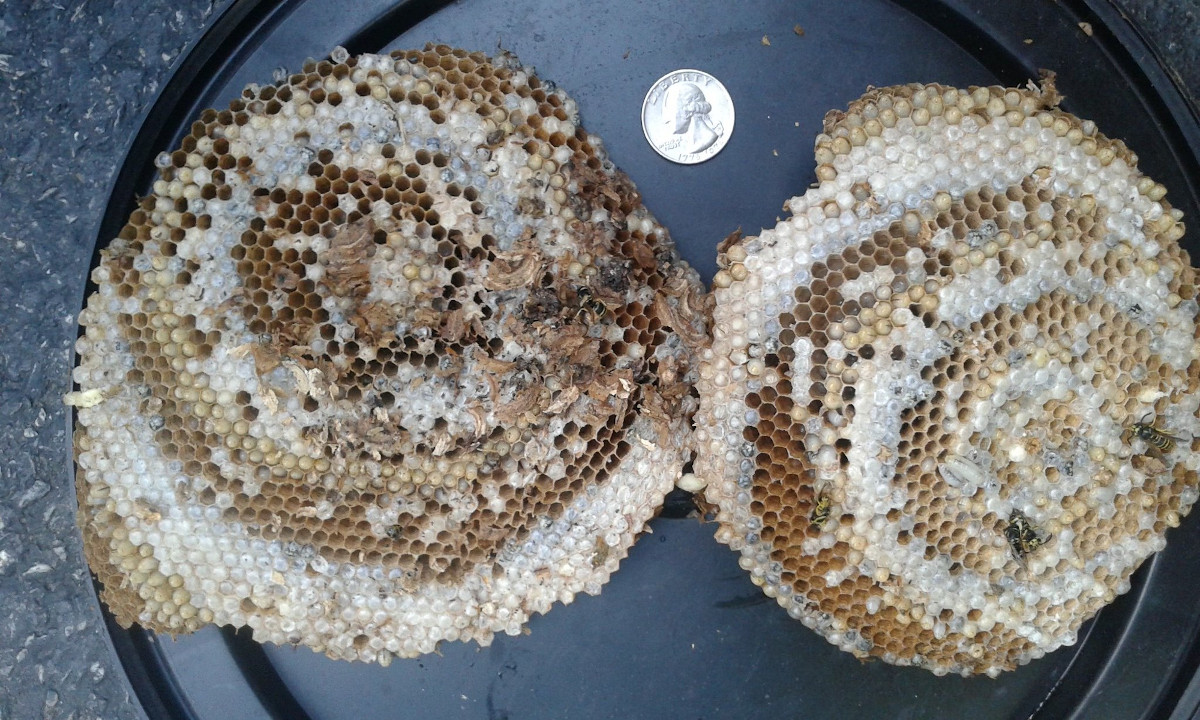 Photo by Praxis
Photo by Praxis
Nest disturbances are the cause of almost all yellowjacket stings. Nests are most often constructed underground in networks of tunnels with cells for raising larvae (young wasps). Occasionally, nests are located in trees, walls or other indoor locations sheltered from the elements. They are constructed of chewed cellulose (plant fiber) glued together with wasp saliva to create elaborate structures of layered architecture, not unlike a multi-level apartment. Nests can have over 10,000 cells. Each cell is ultimately for raising young. Usually, nests are only used for one year, but in warmer climates nests can be used for several years.
Nest identification isn’t as simple as with the Paper Wasp or Mud Dauber, but you will typically see a hole in the ground, a tree, or a wall with many wasps flying in and out of it during the day.
Natural History
Yellowjackets are social insects with fascinating biology. They have a distinct caste system of sterile workers, females, males and a queen. A new colony is started by a single queen at the start of the warm season. After feeding on other insects and flower nectar, she develops eggs and will soon need a nest. The nest starts out small with a few dozen cells, but eventually grows to a few thousand.
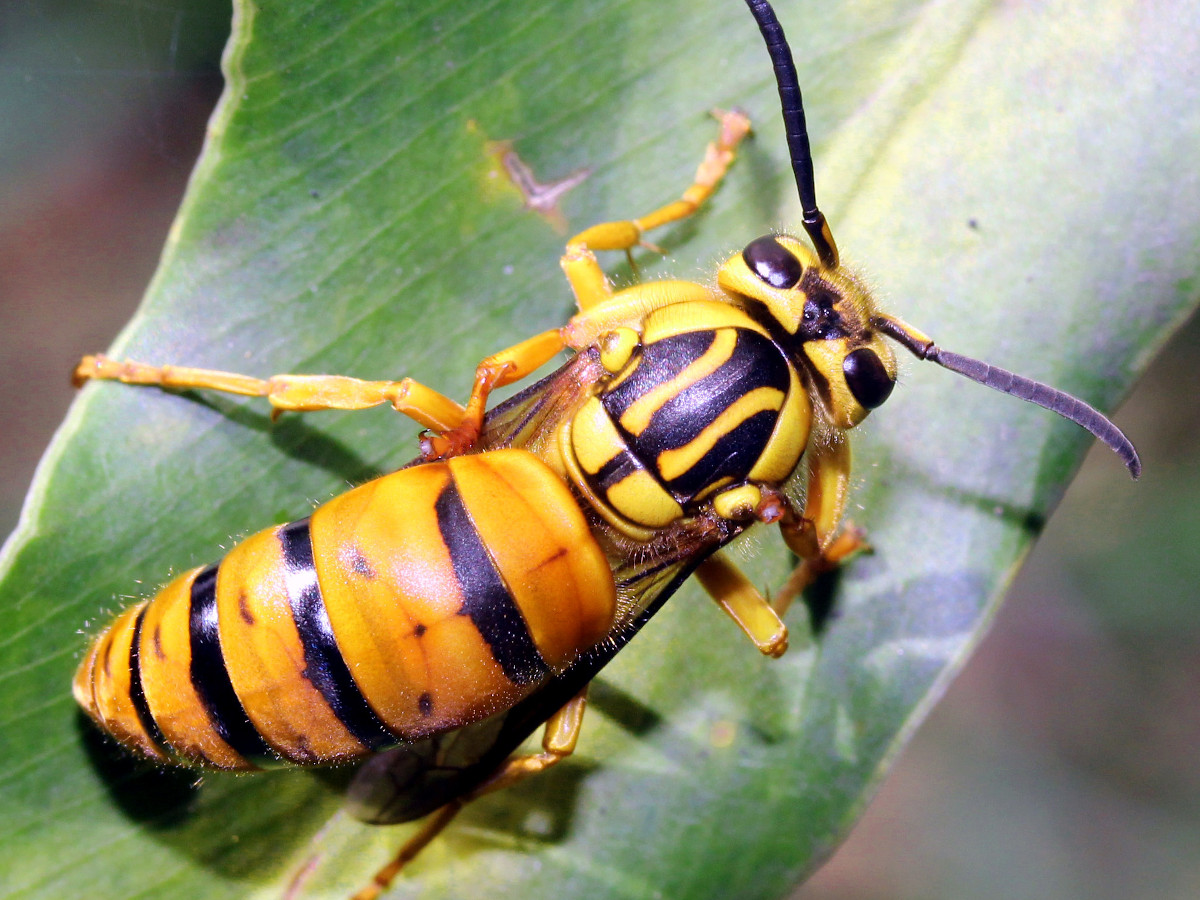 Southern Yellowjacket Queen. Photo by David Hill
Southern Yellowjacket Queen. Photo by David Hill
Once worker wasps are fully on the job, the queen remains in the nest and relies on the workers for her own survival and caring for the wasp larvae. Larvae are fed caterpillars and other insects. Late in the summer, workers construct larger reproductive cells in which male and female wasps are produced. They soon leave the nest and mate. The queen then finds a hibernation site while males swarm in high numbers over hilltops and vegetation.
Food consists of insects and small animal carcasses, picnic scraps, garbage and just about any other source of protein. Spiders and garden caterpillars are commonly preyed upon by yellowjackets. As larvae develop in the cells of the nest, workers bring prey to feed them in a rare example of parental care in insects.
Southern yellowjacket queens are known to steal functioning nests from other species of yellowjackets. Because of this behavior, they are considered facultative social parasites. This means that they don't need to do this for survival, but parasitism is always an option for queens. In some areas of the deep south, up to 80% of southern yellowjacket nests show signs of parasitic origins.
Are Yellowjacket wasps Dangerous?
Yellowjackets sting when provoked (and it hurts)
These wasps are known for aggressively defending their nests. The good news is that they rarely sting when scouting or feeding on nectar at picnics and other outdoor activities.
Most swarms of stinging workers occur during attempted nest removals. Stings are intensely painful, and inflammation, fatigue and itching last for hours afterward. If symptoms get worse rather than improving after the first few hours following a sting, seek medical treatment as an infection may be occuring. While infections are extremely rare, anaphylactic allergic reactions occur in 4 out out 1,000 children. Symptoms include trouble breathing and swallowing and hives within two hours of the sting.
How To Remove Yellowjacket Nests
If nests are sufficiently away from areas you and your family frequent, it's best to leave the yellowjacket nest alone and mark the area with a warning sign. In November or December after the first hard freeze, most yellow jacket nests die; abandoned nests can be plugged up to prevent them from being your neighbor next year.
If you must get rid of the colony by plugging the nest, consider these Earth-friendly methods.
- Soap and water - Obtain mesh or a landscaping fabric that prevents wasps from escaping but allows water to pass through. Mix a few squirts of dish detergent in one gallon of water. Cover the entrance to the nest at dusk or dawn when the wasps are least active. Cut a very small hole over the nest entrance and then pour the soap solution into the nest. The bubbles and fluid will prevent wasps from flying out.
- Diatomaceous Earth - Diatomaceous earth is made of crushed fossilized remains in the form of silica. While soft to the touch for humans, this powder feels like shards of glass to insects. It will damage the wings of wasps and gradually kill any insects that come in contact with it. Diatomaceous earth can be used to treat the whole hive. Place some around the nest opening, spreading it across a one foot diameter area. Pour some down into the nest openings at dusk or dawn while wearing protective clothing such as long sleeves, gloves and glasses. It will need to be reapplied after rainfall.
Keep Yellowjackets away
Garbage cans can be attractive to foraging yellowjacket wasps. It's important to keep all garbage receptacles closed when not in use. Yellowjacket wasp traps are commercially available and may help to reduce foraging numbers somewhat when properly maintained. However, these devices do not eliminate nests.
Wasp control should not be attempted by anyone with a heart condition or known allergies to bee or wasp venom. If uncertainties or dangerous challenges exist with regards to your health or the nest location, call a pest removal professional.
Facts About Yellowjackets
- Nest architecture can be studied to determine if a yellowjacket wasp has parasitic origins. New additions of a nest can be built in very different architectural styles.
- Yellowjackets release alarm pheromones that send chemical signals to other worker wasps in the event of a threat to the nest, enabling swarm behavior. Venom glands on the head and stomach release the pheromones.
- The largest nests in Texas were over 6 feet across, but even larger nests have been studied in Florida.
- Yellowjackets and many other wasps are rare examples of parental care in insects. Larvae are carefully raised and protected in the cells within the nest as they are fed insect prey until pupation.
- Southern yellowjackets (Vespula squamosa) are polygynous with more than one queen occupying a nest. Other species have one queen per nest. Scientists are not sure what the benefit of polygyny is for these wasps.
- There are at least 28 species in the Vespula genus, but scientists suspect there may be more species yet to be discovered by science. There's even a distinct population of southern yellowjackets in the mountains of Mexico that may someday be declared a distinct species.
- The 410,000 acre Ranch Fire that burned Northern California in 2019 was started by a rancher plugging an underground wasp nest. Sparks flew as a metal stake was hammered into the ground.
Helpful Links
https://txbeeinspection.tamu.edu/public/bee-identification/yellow-jackets/
https://entomology.tamu.edu/studylist_all/yellowjackets/
https://texasinsects.tamu.edu/southern-yellowjackets/
https://www.discoverlife.org/mp/20q?search=Vespula+squamosa
https://naldc.nal.usda.gov/download/CAT82762500/PDF